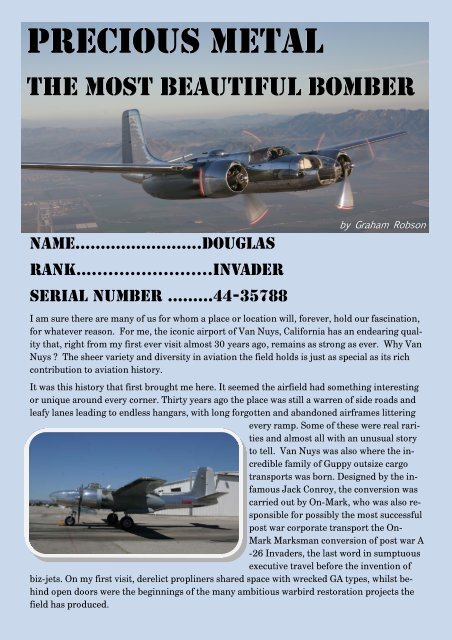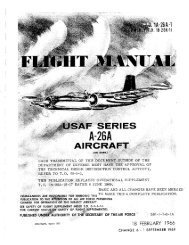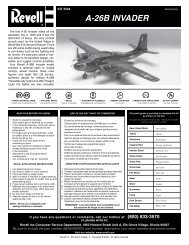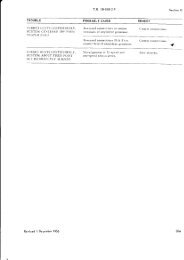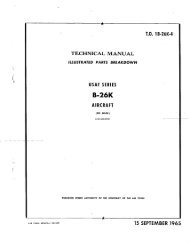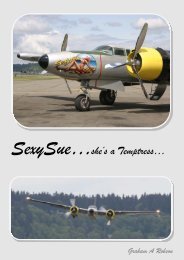Article 2 - Precious Metal, the most beautiful bomber
Article 2 - Precious Metal, the most beautiful bomber
Article 2 - Precious Metal, the most beautiful bomber
Create successful ePaper yourself
Turn your PDF publications into a flip-book with our unique Google optimized e-Paper software.
PRECIOUS METAL<br />
THE MOST BEAUTIFUL BOMBER<br />
Name…………………….Douglas<br />
Rank…......................Invader<br />
Serial Number ………44-35788<br />
by Graham Robson<br />
I am sure <strong>the</strong>re are many of us for whom a place or location will, forever, hold our fascination,<br />
for whatever reason. For me, <strong>the</strong> iconic airport of Van Nuys, California has an endearing quality<br />
that, right from my first ever visit al<strong>most</strong> 30 years ago, remains as strong as ever. Why Van<br />
Nuys ? The sheer variety and diversity in aviation <strong>the</strong> field holds is just as special as its rich<br />
contribution to aviation history.<br />
It was this history that first brought me here. It seemed <strong>the</strong> airfield had something interesting<br />
or unique around every corner. Thirty years ago <strong>the</strong> place was still a warren of side roads and<br />
leafy lanes leading to endless hangars, with long forgotten and abandoned airframes littering<br />
every ramp. Some of <strong>the</strong>se were real rarities<br />
and al<strong>most</strong> all with an unusual story<br />
to tell. Van Nuys was also where <strong>the</strong> incredible<br />
family of Guppy outsize cargo<br />
transports was born. Designed by <strong>the</strong> infamous<br />
Jack Conroy, <strong>the</strong> conversion was<br />
carried out by On-Mark, who was also responsible<br />
for possibly <strong>the</strong> <strong>most</strong> successful<br />
post war corporate transport <strong>the</strong> On-<br />
Mark Marksman conversion of post war A<br />
-26 Invaders, <strong>the</strong> last word in sumptuous<br />
executive travel before <strong>the</strong> invention of<br />
biz-jets. On my first visit, derelict propliners shared space with wrecked GA types, whilst behind<br />
open doors were <strong>the</strong> beginnings of <strong>the</strong> many ambitious warbird restoration projects <strong>the</strong><br />
field has produced.
It was on one of <strong>the</strong>se visits to Van Nuys<br />
that I first made <strong>the</strong> acquaintance of<br />
one very special person with a similar<br />
ambitious project, Mr Howard Keck. A<br />
very successful business man with a<br />
passion for airplanes and <strong>the</strong>ir history<br />
that is evident from <strong>the</strong> first meeting.<br />
Inside Mr Keck’s particular hangar was<br />
a partially dismantled Douglas A-26C<br />
Invader airframe, ra<strong>the</strong>r appropriate for<br />
Van Nuys I thought, which he told<br />
would become <strong>the</strong> last word in Invader<br />
restorations when it was finished. Unlike <strong>the</strong> On-Mark examples before it, this Invader had not<br />
succumbed to any modicum of ‘civilianization’ and was, according to Howard, <strong>the</strong> best example<br />
of its kind anywhere in <strong>the</strong> world. Although in a slightly dishevelled state, in <strong>the</strong> early stages of a<br />
full ‘ground-up’ restoration, it was clear that this airframe was completely intact and, would indeed,<br />
become a <strong>beautiful</strong> airplane once again, something I would eagerly look forward to seeing<br />
when <strong>the</strong> time came. Over <strong>the</strong> ensuing years Mr Keck and I remained in regular contact on <strong>the</strong><br />
progress of <strong>the</strong> restoration and, upon hearing that <strong>the</strong> Invader was ready to return to <strong>the</strong> air, very<br />
keenly and happily accepted his very generous invitation to come and fly with and photograph it,<br />
<strong>the</strong> results of which illustrate this article.<br />
Perhaps not <strong>the</strong> best known or recognised example of America’s prodigious wartime <strong>bomber</strong> production,<br />
it subsequently gained notoriety for having served in more <strong>the</strong>atres of conflict than any<br />
of its equals. Korea, Vietnam, <strong>the</strong> Belgian Congo, Biafra, Indonesia all operated Invaders and it<br />
gained favour with<br />
many Central America<br />
dictatorships, where <strong>the</strong><br />
type flew with <strong>the</strong><br />
armed forces of many of<br />
<strong>the</strong> countries in this region.<br />
Even today, Invaders<br />
continue to do<br />
battle in <strong>the</strong> Pacific<br />
Northwest fighting an<br />
enemy that can never be<br />
bombed to <strong>the</strong> negotiating<br />
table, forest fires !<br />
A product of <strong>the</strong> legendary designer Ed Heinemann, <strong>the</strong> Invader suffered a slow and protracted<br />
development, eventually reaching combat units in Europe and <strong>the</strong> south west Pacific during <strong>the</strong><br />
closing stages of World War Two. The high speed and sleek design featured an innovative and<br />
highly advanced laminar flow wing design, bestowing terrific performance to such a large aircraft
and one of <strong>the</strong> important<br />
factors for its later popularity<br />
in <strong>the</strong> post war corporate<br />
world. Its combat<br />
qualities included two<br />
remotely-controlled gun<br />
turrets equipped with<br />
twin .50 calibre machine<br />
guns, controlled from <strong>the</strong><br />
gunner’s position in <strong>the</strong><br />
rear fuselage, which<br />
could be augmented by<br />
various nose armament<br />
configurations, by virtue<br />
of inter-changeable nose<br />
sections, depending upon<br />
<strong>the</strong> Invader sub-type. This was all incorporated around an immensely long weapons bay, intended<br />
to carry aerial torpedos, though never actually used operationally. Early models had a<br />
ra<strong>the</strong>r clumsy cockpit glazing configuration, which lead to problems in early service, which<br />
forced changes in operational mission formations due to <strong>the</strong> poor visibility to <strong>the</strong> forward right<br />
from <strong>the</strong> single pilot seating position.<br />
These troubles initially lead to <strong>the</strong> type being blacklisted by both <strong>the</strong> 3 rd and 5 th Air Forces,<br />
though it excelled in <strong>the</strong> European <strong>the</strong>atre of operations where it was seen as <strong>the</strong> perfect replacement<br />
for <strong>the</strong> A-20 Havoc, eventually replacing <strong>most</strong> Bombardment Groups’ Martin B-26 Marauders<br />
and North American B-25s. The canopy problem was eventually overcome in late 1944,<br />
with <strong>the</strong> adoption of <strong>the</strong> now familiar style glazing came to <strong>the</strong> fore, though <strong>the</strong> new bulged design<br />
prevented <strong>the</strong> upper turret guns being fixed in a forward position, for strafing by <strong>the</strong> pilot.<br />
Douglas A-26C Invader N126HK turns heads where ever is goes and is <strong>the</strong> mark against which all<br />
o<strong>the</strong>r warbird restorations should be judged. Unlike many contemporaries, which seem to be as<br />
much ‘new-build’ as genuine original parts, this vintage 65 year old shows no such dubious provenance.<br />
This Invader’s value is fur<strong>the</strong>r enhanced by never having suffered any form of<br />
‘civilianisation’ following military demob, instead it remained in complete stock military configuration,<br />
quite a rarity indeed for a<br />
survivor of this breed.<br />
With an immense affection for <strong>the</strong><br />
type, proud owner Howard ensured<br />
<strong>the</strong> restoration of this classic was<br />
without compromise. Although <strong>the</strong><br />
exact history of 44-35788 immediately<br />
after it was saved from <strong>the</strong><br />
smelter in <strong>the</strong> late 1940s has not<br />
been documented with any certainty.<br />
It is known that <strong>the</strong> L.B. Smith<br />
Aircraft Corporation of Miami, Florida purchased <strong>the</strong> aircraft from <strong>the</strong> War Assets Administration<br />
sometime in <strong>the</strong> late 1940s. L B Smith specialised in <strong>the</strong> refurbishment and modification of
former military C-46 and C-82 airframes as well as producing components for airliner interiors.<br />
The company hit upon <strong>the</strong> idea of using <strong>the</strong> Invader airframe as a basis for a completely new executive<br />
transport, named <strong>the</strong> Biscayne. After one conversion, <strong>the</strong> company decided to re-think<br />
things and scratch build a whole new fuselage, which was mated to Invader wings and empennage,<br />
which it named <strong>the</strong> Tempo. L.B. Smith were, ultimately, unsuccessful in <strong>the</strong>ir venture into<br />
aircraft manufacturing, beaten by <strong>the</strong> more popular yet no more practical Invader conversions<br />
from On-Mark, however, not before <strong>the</strong>y had acquired a substantial stockpile of airframes from<br />
which to draw <strong>the</strong>ir potential conversion material, which included N8058E, <strong>the</strong> one time 44-<br />
35788.<br />
It was <strong>the</strong>n rumoured to have been owned by a wealthy Texan businessman in <strong>the</strong> oil industry<br />
and covertly flown by <strong>the</strong> CIA in connection with <strong>the</strong> Bay of Pigs incident against <strong>the</strong> communists<br />
in Cuba in <strong>the</strong> late 1950s. Subsequently, in 1962, it was noted in outside storage at Charlotte,<br />
South Carolina where it languished until as late as 1972, remaining in completely stock military<br />
layout, with <strong>the</strong> exception of a missing upper gun turret. In 1977 it was acquired by warbird collector<br />
John Stokes and moved to<br />
his base at San Marcos, Texas.<br />
Here it remained for <strong>the</strong> next<br />
few years, during which time<br />
ownership transferred to Joe<br />
Mabee of Midland, Texas between<br />
1981and ’82, suggesting a<br />
possible connection to <strong>the</strong> Confederate<br />
Air Force. This was<br />
short lived, however, as in November<br />
1982 <strong>the</strong> Invader was<br />
donated to <strong>the</strong> EAA Aviation<br />
Foundation Museum, at <strong>the</strong>ir<br />
headquarters in Oshkosh, Wisconsin.<br />
A long restoration by<br />
Wiley Sanders in Troy, Alabama was begun in 1987, eventually being returned to Oshkosh in<br />
1994 and placed on static display, occasionally being dragged out to join <strong>the</strong> more active<br />
warbirds on display during <strong>the</strong> annual EAA Oshkosh airshow week in July every year. Upkeep of<br />
<strong>the</strong> Invader was more than <strong>the</strong> EAA Museum could manage and eventually it was decided its future<br />
would be more secure elsewhere. In 2000, Courtesy Aircraft of Rockford, Illinois were contracted<br />
to market <strong>the</strong> sale of <strong>the</strong> Invader on <strong>the</strong> museum’s behalf<br />
Says Howard, “I have always thought that <strong>the</strong> A26 was <strong>the</strong> John Wayne (maybe Cary Grant too)<br />
of <strong>bomber</strong>s, so to speak, and that it deserved a lot of respect”. With such thoughts and a long<br />
time passion for <strong>the</strong> type, Howard made an offer to Courtesy Aircraft and in April 2001 became<br />
<strong>the</strong> new owner, when it was registered to Howard Keck/A-26 Company Inc, Van Nuys, California<br />
as N126HK. “The reason I purchased <strong>the</strong> A26 was because it was <strong>the</strong> lowest airframe time A-26<br />
in <strong>the</strong> world, with little more than 1,200 hours on <strong>the</strong> airframe” and so began a three-year and<br />
very expensive restoration”, which was undertaken by famed aircraft restoration guru and ace air<br />
-racing pilot Matt Jackson. Incredibly, when Howard acquired <strong>the</strong> aircraft it was still in completely<br />
stock military condition and un-restored and, although it had undergone a restoration of
sorts in <strong>the</strong> 1980s, it was rarely, if ever, flown. After being prepared for delivery to Van Nuys,<br />
about one hour into <strong>the</strong> ferry flight home <strong>the</strong> right engine catastrophically blew up, Howard comments<br />
“… luckily, Matt was in <strong>the</strong> left seat not me. He fea<strong>the</strong>red <strong>the</strong> prop, retarded <strong>the</strong> engine<br />
and flew right back to Rockford, Illinois”. Howard shipped out a spare engine he had in <strong>the</strong><br />
hangar, which Matt replaced and flew it back to California without fur<strong>the</strong>r incident. Once safely<br />
inside Howard’s large hangar on Daily Drive at Van Nuys airport, <strong>the</strong> three year long restoration<br />
started.<br />
The renovation took <strong>the</strong> aircraft back to bare bones, revealing<br />
some of its unusual history, including bullet holes in <strong>the</strong><br />
tail area, probable evidence of its nefarious activities concerning<br />
<strong>the</strong> Cuban Bay of Pigs action. Where possible brand<br />
new replacement parts were used in what Howard describes<br />
as a “a fairly boiler plate restoration, costing $3Million,<br />
which is fairly standard for an aircraft of its age”. With nothing<br />
of <strong>the</strong> original airframe modified or changed to accommodate<br />
a civilian life after its demob, this Invader is a truly<br />
rare beast and provided <strong>the</strong> perfect opportunity to re-create<br />
<strong>the</strong> airframe as it would have been back in 1944, in fact probably<br />
better condition owing to <strong>the</strong> loving care lavished upon<br />
it. Well heeled with new wheels and brakes, one of <strong>the</strong> few<br />
concessions to modernity in <strong>the</strong> restoration was <strong>the</strong> use of a<br />
nose wheel from a Convair 440, fitted with a new tyre from a<br />
Gulfstream 3 jet, as used on a number of A-26 fire<strong>bomber</strong>s.<br />
Internally, <strong>the</strong> cockpit was fully refurbished with all new instruments, including some essential<br />
new equipment as befits today’s modern, safety conscious world. One unusual addition specified<br />
by <strong>the</strong> new owner was <strong>the</strong> installation of huge auxiliary bomb-bay fuel tanks, to allow non-stop<br />
transit from California to <strong>the</strong> Hawaiian Islands, which Howard planned though, is yet to do. Two<br />
tanks, one of 125 US gallon in <strong>the</strong> upper forward part of <strong>the</strong> bay, supplemented by an enormous<br />
675 US gallon tank which<br />
extends <strong>the</strong> entire length<br />
of <strong>the</strong> lower bomb-bay<br />
area, was intended to extend<br />
<strong>the</strong> <strong>bomber</strong>s’ ferry<br />
range for delivery flights.<br />
From a total production<br />
run of 2,529 airframes,<br />
built at Long Beach, California<br />
and Tulsa, Oklahoma,<br />
only <strong>the</strong> first and<br />
very last examples of <strong>the</strong><br />
type were delivered from<br />
<strong>the</strong> factory in a painted<br />
scheme, <strong>the</strong> remainder<br />
being completed with
nothing but US national insignia<br />
and <strong>the</strong> plethora of military stencilling<br />
to sully <strong>the</strong> bare metal finish.<br />
As if to emphasize this point, and<br />
sparing no expense, <strong>the</strong> tremendous<br />
effort to return this beauty<br />
back to her former glory was<br />
topped off with, quite possibly, <strong>the</strong><br />
<strong>most</strong> stunning polished finish one<br />
could ever imagine, making <strong>the</strong> Invader<br />
shine better than new, ready<br />
for her first post restoration flight<br />
on August 3 rd 2004.<br />
Such was <strong>the</strong> sight as Howard welcomed me at his hangar, to take up <strong>the</strong> generous invitation for<br />
a rare air-to-air sortie. Having been here before, on a very similar ‘mission’ a few years ago, I was<br />
keenly aware that such plans can, and often do, go awry at <strong>the</strong> last moment for any number of<br />
reasons. This time, however, everything worked like clock-work. The aircraft was in fine order,<br />
sitting patiently outside its luxuriously appointed hangar; my Beech V-tail Bonanza photo-plane<br />
was ready alongside, with both rear cabin windows removed to allow un-obstructed views, as we<br />
chatted and planned <strong>the</strong> sortie waiting for <strong>the</strong> right time to launch in order to optimise <strong>the</strong> <strong>beautiful</strong><br />
late afternoon light. As we taxied to <strong>the</strong> hold at Van Nuys, biz-jets queuing alongside us enquired<br />
as to <strong>the</strong> type, pedigree and history of <strong>the</strong> 50 odd year old beauty that was easily <strong>the</strong> best<br />
looking aircraft at <strong>the</strong> hold for departure. Cleared to take off, we watched <strong>the</strong> Invader accelerate<br />
ahead of us before we began our roll and <strong>the</strong> race to catch it. With <strong>the</strong> Invader easy to pick out<br />
against <strong>the</strong> sunset ahead of us, <strong>the</strong> Bonanza was running in <strong>the</strong> yellow arc on <strong>the</strong> air-speed indicator<br />
to make <strong>the</strong> rendezvous out towards <strong>the</strong> coast, near Point Mugu.
Once both aircraft were safely in a close formation, so began one of <strong>the</strong> <strong>most</strong> delightful and picturesque<br />
photo sorties I have ever experienced, in <strong>the</strong> still late afternoon air <strong>the</strong> polished skin of<br />
<strong>the</strong> Invader sparkled against <strong>the</strong> long shadows on <strong>the</strong> mountains below.<br />
At times, <strong>the</strong> two aircraft were so close <strong>the</strong> deep rumble of <strong>the</strong> Invader’s engines was clearly audible<br />
even over <strong>the</strong> wind noise through <strong>the</strong> open windows and formation signals could be made<br />
by hand motions ra<strong>the</strong>r than radio calls.
After some 45 minutes of cavorting around capturing every conceivable angle and pose, we<br />
closed up for a tight formation return to Van Nuys, descending through <strong>the</strong> familiar sou<strong>the</strong>rn<br />
Californian smog, which at this time of <strong>the</strong> day against a setting sun, becomes a murky curtain of<br />
haze.
With permission from <strong>the</strong> tower, we continued to follow <strong>the</strong> Invader down final approach, close<br />
to its right wingtip, flying low down <strong>the</strong> parallel western taxiway to capture <strong>the</strong> touchdown from<br />
<strong>the</strong> air, before we climbed away to re-join for our final, to land. Magical.


